Abstract
The existence of solutions with localized solitary wave structures is one of the significant characteristics of nonlinear integrable systems. Darboux transformation (DT) is a well-known method for constructing multi-soliton solutions, using a type of localized solitary wave, of integrable systems, but there are still no reports on extending DT techniques to construct such solitary wave solutions of fractional integrable models. This article takes the coupled nonlinear Schrödinger (CNLS) equations with conformable fractional derivatives as an example to illustrate the feasibility of extending the DT and generalized DT (GDT) methods to construct symmetric and asymmetric solitary wave solutions for fractional integrable systems. Specifically, the traditional n-fold DT and the first-, second-, and third-step GDTs are extended for the fractional CNLS equations. Based on the extended GDTs, explicit solutions with symmetric/asymmetric soliton and soliton–rogon (solitrogon) spatial structures of the fractional CNLS equations are obtained. This study found that the symmetric solitary wave solutions of the integer-order CNLS equations exhibit asymmetry in the fractional order case.
1. Introduction
In mathematical physics, there are some effective methods [1,2,3,4,5,6,7,8] for the solitary wave solutions of nonlinear evolution equations, such as the inverse scattering method [1], DT [3], Hirota bilinear approach [4], and the exp-function method [6]. The DT [3] shows its algebraic operation characteristics in constructing multi-soliton solutions [9,10,11,12,13,14], which creates favorable conditions for the GDT [15,16,17] to construct semirational solutions with solitrogon structures [18,19,20,21]. The integrable NLS equations [22,23,24,25], a class of most typical soliton equations, can be used to describe nonlinear phenomena in various fields, such as nonlinear optics, Bose–Einstein condensation, plasma physics, and optical communication. In addition, the NLS-type equations have clear quantum mechanical significance, and can also describe various weakly dispersive and slowly modulated waves. Due to the wide applications of the NLS-type equations, solving such equations is an eternal hot topic for scholars. At the same time, deriving some important nonlinear integrable systems, especially NLS-type equations, is also meaningful research work. As for the new developments in this area, we are willing to mention the reduced NLS equations [26], and modified Korteweg–de Vries (mKdV) equations [27] generated through group reductions of matrix spectral problems. Moreover, the DT method has been applied to such reduced NLS equations [28] and mKdV equations [29]. The derivation of nonlocal integrable equations by group reductions is also feasible. For concrete details, see [30] where N-soliton solutions of the derived nonlocal integrable equations have also been systematically studied by solving Riemann–Hilbert problems. With the developments in fractional calculus [31], the question of how to extend the existing methods for fractional differential equations is a natural research trend [32,33,34,35,36,37,38].
This article aims to extend the DT and GDT for the following conformable fractional CNLS equation:
which is our generalization of the CNLS equation [39], not only to the arbitrary nonzero constant-coefficient and but also to the fractional order . In Equation (1), and are the models of potential functions and , stands for the imaginary unit, and and represent the conformable fractional derivative operators with respect to and [40,41]. Replacing and with and , respectively, and letting , the fractional CNLS Equation (1) is the integer-order CNLS equation [39]. Further taking , then the fractional CNLS Equation (1) degenerates into the classical focusing NLS equation [24]. Interestingly, in the case where , the fractional CNLS Equation (1) can reduce to the classical defocusing NLS equation.
The fractional CNLS Equation (1) has Lax integrability. This is due to the fact that Equation (1) has the fractional Lax pair as below:
with
where denotes the vector eigenfunction of the independent variables and and the isospectral parameter , , , and stands for the complex conjugation.
The other sections of this article are as follows. In Section 2, the n-fold DT for the fractional CNLS Equation (1) is constructed. In Section 3, the GDT with the first three steps for the fractional CNLS Equation (1) is derived based on the constructed n-fold DT. In Section 4, some explicit solitary wave solutions of the fractional CNLS Equation (1) are obtained, including one-soliton and solitrogon solutions with symmetric/asymmetric localized spatial structures. In Section 5, this article is summarized.
2. n-Fold DT for the Fractional CNLS Equation (1)
Firstly, we introduce a gauge transformation in matrix form [18]:
Then, Equation (3) transforms the Lax pair (2) into a new one:
where the iso spectral parameter is complex, is the eigen function.
According to Equations (2), (4) and (5), we arrive at:
namely:
Similarly, by virtue of Equations (3), (4) and (6) we have:
Then, using Equations (5)–(8) yields:
which tells us that the zero curvature equation is equivalent to . In other words, and have the same forms as and except that and are respectively replaced with and .
We next assume that is a polynomial matrix of the first degree:
where and are undetermined functions of and .
By comparing the coefficients of , and in Equation (5), we sequentially have:
which shows that , , , and are all independent to . Similarly, substituting above , and into Equation (6) and comparing all the coefficients of the same powers of , we also find that , , , and are all independent to . In this case, we write as:
To calculate the concrete expressions for , we consider the vector eigen functions , here , and for . Then, it is not difficult to prove that when is the column vector solution of Equation (2) in the case of , then is also the column vector solution of Equation (2). At the same time, we know the fact that the vector satisfies Equation (2). For convenience, we set and .
With the above preparations, we select and , then the first-step DT for the fractional CNLS Equation (1) turns out as:
where the Darboux matrix satisfies:
Equation (12) gives the following linear algebraic equations:
Solving the linear algebraic Equations (13)–(15) by Cramer’s rule with the help of
one can obtain the following solutions:
Then, in Equation (10) is finally determined by the form:
where is, as mentioned earlier, the column vector solution of Equations (2) and (3) with , while . Thus, the relations between the new and former potentials can be derived as follows:
If all the different basic solutions of Equations (2) and (3) with , then the n-fold DT for the fractional CNLS Equation (1) can be iterated smoothly. Continuing the above process and combining all the Darboux matrices, the n-th step DT turns out to be:
where is the column vector solution of Equations (2) and (3) with , and .
3. GDT for the Fractional CNLS Equation (1)
We have constructed in Section 2 the n-th step DT for the fractional CNLS Equation (1), which contains eigenfunctions combined with the given eigenvalues . Based on the constructed DT, we gain . It is obvious that the DT under this case cannot be applied on again. We then suppose that is a special solution of Equations (2) and (3). In this way, we can infer that is also a solution of Equations (2) and (3), where is a small parameter. Expanding in Taylor series at yields:
with
We find that solves Equations (2) and (3) with and associated seed solutions and . Thus, we have the first-step GDT for the fractional CNLS Equation (1):
where and .
For the second-step GDT for the fractional CNLS Equation (1), we then obtain the second iterated GDT via the limit process:
where and are already given in Equation (21). Thus, associated with can be determined by means of Equation (24). Let us assume . When , we can obtain the second-step GDT of the fractional CNLS Equation (1) by replacing related variables in Equation (19) in the limit case of :
where and .
For the third-step GDT of the fractional CNLS Equation (1), we calculate:
where , and are known via Equation (18). Therefore, is determined by means of Equation (27). We suppose , then the third-step GDT for the fractional CNLS Equation (1) can be constructed as follows:
where and .
4. Symmetric and Asymmetric Solitary Wave Solutions of the Fractional NLS Equation (1)
In the previous sections, we have constructed the necessary formulae to generate exact solutions of the fractional NLS Equation (1), including soliton solutions and solitrogon solutions. In this part, we calculate several explicit solutions of the fractional NLS Equation (1) by employing these formulae.
We start with the one-soliton solutions by taking the seed solutions and . Substituting these two seed solutions into Equations (2) and (3), and solving the resultant equations, we derive the following column vector solution with :
Substituting above into Equation (23), we can obtain the one-soliton solutions of the fractional NLS Equation (1). When we set , , and , the one-soliton solutions are obtained as follows:
When letting , , and , the one-soliton solutions of the fractional NLS Equation (1) read:
Using Formulae (24) and (26), we can straight-forwardly obtain the solitrogon solutions of the fractional CNLS Equation (1). Based on Equation (30), the solutions with , , and can be expressed as:
When , , and , Formulas (24) and (26) help us use Solution (31) to obtain the solitrogon solutions of the fractional NLS Equation (1):
Two space-time structures of Solution (30) are shown in Figure 1 by setting . We can see from Figure 2 that the symmetric one-soliton determined by Solution (30) with has asymmetry when is selected. With the same fractional order as Figure 2 but different constants and , we show in Figure 3 another two asymmetric one-solitons determined by Solution (30).
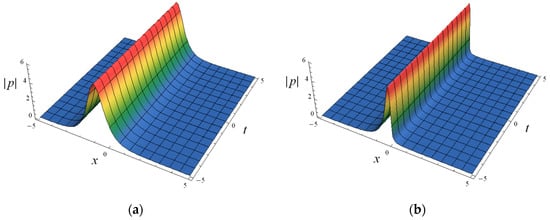
Figure 1.
Symmetric and asymmetric space-time structures of Solution (30) with different fractional orders: (a) α = 1; (b) α = 5/11.
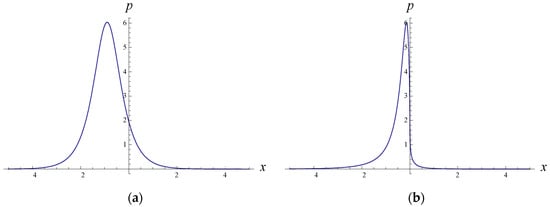
Figure 2.
Symmetric and asymmetric bell one-solitons determined by Solution (30) with different fractional orders: (a) α = 1; (b) α = 5/11 at the time t = 0.
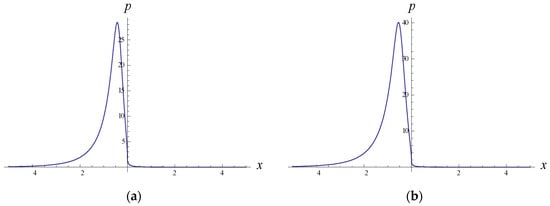
Figure 3.
Asymmetric bell one-solitons determined by solution (30) with fractional order α = 5/11 and different values of a: (a) a = 0.01i; (b) a = 0.05i at the time t = 0.
In Figure 4, Figure 5 and Figure 6, the asymmetric solitrogon and two-soliton structures determined by Solution (32) are shown, there . It is seen that whether the fractional order or , the bell solitrogons are all asymmetric at the time , but the bell two-soliton part of the solitrogon with is symmetric while the one corresponding to is asymmetric at . In Figure 7, another pair of asymmetric solitrogon structures determined by Solution (32) are shown, there the constant has been selected as and , respectively. Figure 3 and Figure 7 show that all the amplitudes of the solitary waves increase with the decrease in the imaginary part of . As the real value of decreases, a similar phenomenon of increasing the amplitudes of solitary waves also occurs. The law of amplitude variation shown in Figure 3 and Figure 7 can also be understood mathematically by analyzing the expressions of Equations (30) and (32).
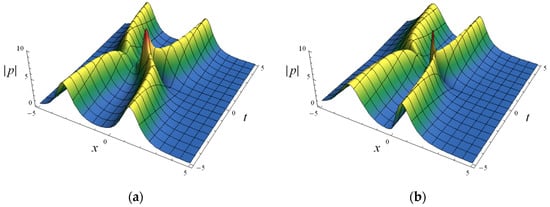
Figure 4.
Asymmetric space-time structures of Solution (32) with different fractional orders: (a) α = 1; (b) α = 7/11.
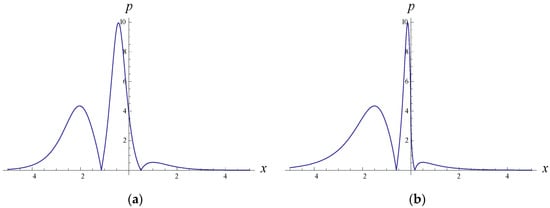
Figure 5.
Asymmetric bell solitrogons determined by Solution (32) with different fractional orders: (a) α = 1; (b) α = 7/11 at the time t = 0.
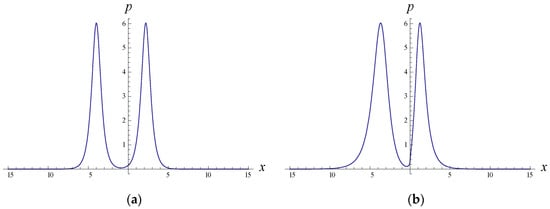
Figure 6.
Symmetric and asymmetric bell two-soliton parts of the solitrogons determined by Solution (32) with different fractional orders: (a) α = 1; (b) α = 7/11 at the time t = 30.
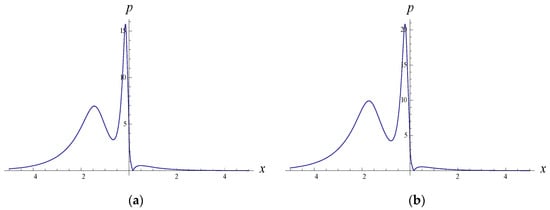
Figure 7.
Asymmetric bell solitrogons determined by Solution (32) with fractional order α = 7/11 and different values of a: (a) a = 0.01i; (b) a = 0.05i at the time t = 0.
5. Conclusions and Discussions
In terms of the first iteration Formulae (18) and (23), we can easily recognize that there is essentially no difference between the DT and GDT for the fractional CNLS Equation (1). However, the n-fold GDT with has advantage over the n-fold DT in constructing other types of solutions, for example, solitrogon solutions and rogue wave solutions for the fractional CNLS Equation (1). As for the findings of this article, we would like to mention the following aspects: (i) the derivation of the integrable fractional CNLS Equation (1) with fractional Lax pair (2); (ii) the construction of the n-fold DT (20) and the first, second, and third iteration Formulae (23), (26) and (29) of GDT for the fractional NLS Equation (1); (iii) the example illustration of the feasibility simulating asymmetric solitary wave solutions of the fractional NLS Equation (1) via the dominant role of fractional order ; (iv) the adjustability of the amplitudes of solitary waves localized in Solutions (30) and (32) can be controlled by the value of constant ; (v) the beginning of extending DT and GDT to construct soliton and solitrogon solutions of nonlinear fractional integrable systems; (vi) the predictability of constructing rogue wave solutions, especially the asymmetric ones for the fractional NLS Equation (1) using the GDT. Due to the asymmetry being a significant feature of rogue waves, it is worth studying how to fully utilize the dominant role of fractional order in the construction of rogue waves for fractional models.
Author Contributions
Methodology, S.Z., F.Z. and B.X.; software, B.X. and S.Z.; writing—original draft preparation, S.Z. and F.Z.; writing—review and editing, S.Z. All authors have read and agreed to the published version of the manuscript.
Funding
S.Z. and B.X.were supported by the Liaoning BaiQianWan Talents Program of China (grant No. 2020921037), S.Z. was supported by the Natural Science Foundation of Education Department of Liaoning Province of China (grant No. LJ2020002), S.Z. and B.X. were supported by the National Science Foundation of China (grant No. 11547005), and S.Z. and B.X. were supported by the Natural Science Foundation of Xinjiang Autonomous Region of China (grant No. 2020D01B01).
Data Availability Statement
All the data supporting the findings of this study are available within the article.
Conflicts of Interest
The authors declare that there are no conflict of interest regarding the publication of this article.
References
- Gardner, C.S.; Greene, J.M.; Kruskal, M.D.; Miura, R.M. Method for solving the Korteweg-deVries equation. Phys. Rev. Lett. 1967, 19, 1095–1097. [Google Scholar] [CrossRef]
- Ablowitz, M.J.; Clarkson, P.A. Solitons, Nonlinear Evolution Equations and Inverse Scattering; Cambridge University Press: Cambridge, USA, 1991. [Google Scholar]
- Matveev, V.B.; Salle, M.A. Darboux Transformation and Soliton; Springer: Berlin, Germany, 1991. [Google Scholar]
- Hirota, R. Exact envelope-soliton solutions of a nonlinear wave equation. J. Math. Phys. 1973, 14, 805–809. [Google Scholar] [CrossRef]
- Wang, M.L. Exact solutions for a compound KdV-Burgers equation. Phys. Lett. A 1996, 213, 279–287. [Google Scholar] [CrossRef]
- He, J.H.; Wu, X.H. Exp-function method for nonlinear wave equations. Chaos Soliton. Fract. 2006, 30, 700–708. [Google Scholar] [CrossRef]
- Zhang, S.; Xia, T.C. A generalized auxiliary equation method and its application to (2+1)-dimensional asymmetric Nizhnik-Novikov-Vesselov equations. J. Phys. A Math. Theor. 2007, 40, 227–248. [Google Scholar] [CrossRef]
- Zeng, X.H.; Wu, X.L.; Lang, C.Z.; Yuan, C.P.; Cai, J.P. Exact solutions for coupled variable coefficient KdV equation via quadratic Jacobi’s elliptic function expansion. Symmetry 2023, 15, 1021. [Google Scholar] [CrossRef]
- Fan, E.G. Darboux transformation and soliton-like solutions for the Gerdjikov-Ivanov equation. J. Phys. A Gen. Phys. 2000, 33, 6925–6934. [Google Scholar] [CrossRef]
- Fan, E.G. Explicit N-Fold Darboux transformations and soliton solutions for nonlinear derivative Schrödinger equations. Commun. Theor. Phys. 2001, 35, 650–656. [Google Scholar]
- Huang, D.J.; Li, D.S.; Zhang, H.Q. Explicit N-fold Darboux transformation and multi-soliton solutions for the (1+1)-dimensional higher-order Broer-Kaup system. Chaos Soliton. Fract. 2007, 33, 1677–1685. [Google Scholar] [CrossRef]
- Wen, X.Y. N-fold Darboux transformation and soliton solutions for Toda lattice equation. Rep. Math. Phys. 2011, 68, 211–223. [Google Scholar] [CrossRef]
- Ling, L.M.; Zhao, L.C.; Guo, B.L. Darboux transformation and multi-dark soliton for N-component nonlinear Schrödinger equations. Nonlinearity 2015, 28, 3243–3261. [Google Scholar] [CrossRef]
- Sun, H.Q.; Zhu, Z.N. Darboux transformation and soliton solution of the nonlocal generalized Sasa–Satsuma equation. Mathematics 2023, 11, 865. [Google Scholar] [CrossRef]
- Guo, B.L.; Ling, L.M.; Liu, Q.P. Nonlinear Schrödinger equation: Generalized Darboux transformation and rogue wave solutions. Phys. Rev. E 2012, 85, 026607. [Google Scholar] [CrossRef] [PubMed]
- Guo, B.L.; Ling, L.M.; Liu, Q.P. High-order solutions and generalized Darboux transformations of derivative nonlinear Schrödinger equations. Stud. Appl. Math. 2013, 130, 317–344. [Google Scholar] [CrossRef]
- Guo, B.L.; Tian, L.X.; Yan, Z.Y.; Lin, L.M. Rogue Wave and Its Mathematical Theory; Zhejiang Science and Technology Press: Zhejiang, China, 2015. [Google Scholar]
- Zhang, G.Q.; Yan, Z.Y. Three-component nonlinear Schrodinger equations: Modulational instability, Nth-order vector rational and semi-rational rogue waves, and dynamics. Commun. Nonlinear Sci. Numer. Simula. 2018, 62, 403–413. [Google Scholar] [CrossRef]
- Jiang, Y.; Qu, Q.X. Some semirational solutions and their interactions on the zero-intensity background for the coupled nonlinear Schrdinger equations. Commun. Nonlinear Sci. Numer. Simula. 2019, 67, 403–413. [Google Scholar] [CrossRef]
- Zhang, H.Y.; Zhang, Y.F. Generalized Darboux transformation, semi-rational solutions and novel degenerate soliton solutions for a coupled nonlinear Schrdinger equation. Eur. Phys. J. Plus 2021, 136, 459. [Google Scholar] [CrossRef]
- Zhang, S.; Li, Y.; Xu, B. Solitons, rogon-solitons and their propagations and reflections in three-component coupled nonlinear Schrödinger equation. Optik 2023, 272, 170338. [Google Scholar] [CrossRef]
- Kruglov, V.I.; Peacock, A.C.; Harvey, J.D. Exact self-similar solutions of the generalized nonlinear Schrödinger equation with distributed coefficients. Phys. Rev. Lett. 2003, 90, 113902. [Google Scholar] [CrossRef]
- Serkin, V.N.; Hasegawa, A.; Belyaeva, T.L. Nonautonomous solitons in external potentials. Phys. Rev. Lett. 2007, 98, 074102. [Google Scholar] [CrossRef]
- Yang, J.K. Nonlinear Waves in Integrable and Nonintegrable Systems; SIAM: Philadelphia, PA, USA, 2010. [Google Scholar]
- Liu, W.M.; Kengne, E. Schrödinger Equations in Nonlinear Systems; Springer Nature Singapore Pte Ltd.: Singapore, 2019. [Google Scholar]
- Ma, W.X. Matrix integrable fourth-order nonlinear Schrödinger equations and their exact soliton solutions. Chin. Phys. Lett. 2022, 39, 100201. [Google Scholar] [CrossRef]
- Ma, W.X. Matrix integrable fifth-order mKdV equations and their soliton solutions. Chin. Phys. B 2023, 32, 020201. [Google Scholar] [CrossRef]
- Ma, W.X.; Batwa, S. A binary Darboux transformation for multicomponent NLS equations and their reductions. Anal. Math. Phys. 2021, 11, 44. [Google Scholar] [CrossRef]
- Ma, W.X. Binary Darboux transformation for general matrix mKdV equations and reduced counterparts. Chaos Soliton. Fract. 2021, 146, 110824. [Google Scholar] [CrossRef]
- Ma, W.X. Soliton hierarchies and soliton solutions of type (−λ*, −λ) reduced nonlocal nonlinear Schrödinger equations of arbitrary even order. Partial Differ. Equ. Appl. Math. 2023, 7, 100515. [Google Scholar] [CrossRef]
- Podlubny, I. Fractional Differential Equations; Academic Press: San Diego, CA, USA, 1999. [Google Scholar]
- Fujioka, J.; Espinosa, A.; Rodríguez, R.F. Fractional optical solitons. Phys. Lett. A 2010, 374, 1126–1134. [Google Scholar] [CrossRef]
- He, J.H. A new fractal derivation. Therm. Sci. 2011, 15, S145–S147. [Google Scholar] [CrossRef]
- Zhang, S.; Zhang, H.Q. Fractional sub-equation method and its applications to nonlinear fractional PDEs. Phys. Lett. A 2011, 375, 1069–1073. [Google Scholar] [CrossRef]
- He, J.H. A tutorial review on fractal spacetime and fractional calculus. Int. J. Theor. Phys. 2014, 53, 3698–3718. [Google Scholar] [CrossRef]
- Yang, X.J.; Baleanu, D.; Srivastava, H.M. Local Fractional Integral Transforms and Their Applications; Academic Press: London, UK, 2015. [Google Scholar]
- Xu, B.; Zhang, S. Riemann-Hilbert approach for constructing analytical solutions and conservation laws of a local time-fractional nonlinear Schrödinger equation. Symmetry 2021, 13, 1593. [Google Scholar] [CrossRef]
- Ablowitz, M.J.; Been, J.B.; Carr, L.D. Fractional integrable nonlinear soliton equation. Phys. Rev. Lett. 2022, 128, 184101. [Google Scholar] [CrossRef] [PubMed]
- Guo, B.L.; Ling, L.M. Rogue wave, breathers and bright-dark-rogue solutions for the coupled Schrödinger equations. Chin. Phys. Lett. 2011, 28, 110202. [Google Scholar] [CrossRef]
- Khalil, R.; Horani, A.M.; Yousef, A.; Sababheh, M. A new definition of fractional derivative. J. Comput. Appl. Math. 2014, 264, 65–70. [Google Scholar] [CrossRef]
- Xu, B.; Zhang, Y.F.; Zhang, S. Line soliton interactions for shallow ocean-waves and novel solutions with peakon, ring, conical, columnar and lump structures based on fractional KP equation. Adv. Math. Phys. 2021, 2021, 6664039. [Google Scholar] [CrossRef]
Disclaimer/Publisher’s Note: The statements, opinions and data contained in all publications are solely those of the individual author(s) and contributor(s) and not of MDPI and/or the editor(s). MDPI and/or the editor(s) disclaim responsibility for any injury to people or property resulting from any ideas, methods, instructions or products referred to in the content. |
© 2023 by the authors. Licensee MDPI, Basel, Switzerland. This article is an open access article distributed under the terms and conditions of the Creative Commons Attribution (CC BY) license (https://creativecommons.org/licenses/by/4.0/).